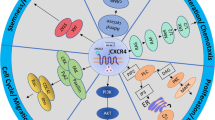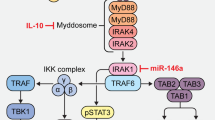Abstract
Waldenström’s Macroglobulinemia (WM) is a rare disease of the elderly with a median age of 63–68 years at diagnosis. Despite recent progress in biological insights and therapeutics, WM remains clinically challenging to diagnose and is difficult to manage with significant morbidity and lack of established curative therapies. Recently, the use of whole-genome sequencing has helped to identify a highly recurrent somatic mutation, myeloid differentiation factor 88 [MYD88] L265P in WM. This has fueled major interest in the field and as newer evidence accumulates, it is clear that that discovery of MYD88 L265P mutation may represent an important breakthrough in understanding the pathogenesis of WM and lymphoproliferative disorders. Recent scientific work in this field has also guided the identification of new targets such as CXCR4 and PI3K-delta that may have major implications in the future treatment of WM. This review discusses the role of MYD88 L265P mutations as well as targets beyond MYD88 in the setting of pathogenesis and development of future rational therapeutic trials focusing on patients diagnosed with WM.
This is a preview of subscription content, access via your institution
Access options
Subscribe to this journal
Receive 12 print issues and online access
$259.00 per year
only $21.58 per issue
Buy this article
- Purchase on Springer Link
- Instant access to full article PDF
Prices may be subject to local taxes which are calculated during checkout

Similar content being viewed by others
References
Groves FD, Travis LB, Devesa SS, Ries LA, Fraumeni JF Jr . Waldenstrom's macroglobulinemia: incidence patterns in the United States 1988-1994. Cancer 1998; 82: 1078–1081.
Braggio E, Philipsborn C, Novak A, Hodge L, Ansell S, Fonseca R . Molecular pathogenesis of Waldenstrom's macroglobulinemia. Haematologica 2012; 97: 1281–1290.
Buske C, Leblond V . How to manage Waldenstrom's macroglobulinemia. Leukemia 2013; 27: 762–772.
Leleu X, Eeckhoute J, Jia X, Roccaro AM, Moreau AS, Farag M et al. Targeting NF-kappaB in Waldenstrom macroglobulinemia. Blood 2008; 111: 5068–5077.
Treon SP, Xu L, Yang G, Zhou Y, Liu X, Cao Y et al. MYD88 L265P somatic mutation in Waldenstrom's macroglobulinemia. N Engl J Med 2012; 367: 826–833.
Kawai T, Akira S . Toll-like receptor and RIG-I-like receptor signaling. Ann N Y Acad Sci 2008; 1143: 1–20.
Warner N, Nunez G . MyD88: a critical adaptor protein in innate immunity signal transduction. J Immunol 2013; 190: 3–4.
Cao Y, Hunter ZR, Liu X, Yang G, Tripsas CK, Manning R et alSomatic Activating Mutations In CXCR4 Are Common In Patients With Waldenstrom’s Macroglobulinemia, and Their Expression In WM Cells Promotes Resistance To Ibrutinib Blood (ASH Annual Meeting Abstracts), December 2013; 4424 2013.
Yang G, Xu L, Zhou Y, Xu L, Cao Y, Manning R et alPI3K/AKT Pathway Is Activated By MYD88 L265P and Use Of PI3K-Delta Inhibitors Induces Robust Tumor Cell Killing In Waldenstrom’s Macroglobulinemia Blood (ASH Annual Meeting Abstracts), December 2013; 4255.
Lord KA, Hoffman-Liebermann B, Liebermann DA . Nucleotide sequence and expression of a cDNA encoding MyD88, a novel myeloid differentiation primary response gene induced by IL6. Oncogene 1990; 5: 1095–1097.
Muzio M, Ni J, Feng P, Dixit VM . IRAK (Pelle) family member IRAK-2 and MyD88 as proximal mediators of IL-1 signaling. Science 1997; 278: 1612–1615.
Wesche H, Henzel WJ, Shillinglaw W, Li S, Cao Z . MyD88: an adapter that recruits IRAK to the IL-1 receptor complex. Immunity 1997; 7: 837–847.
Adachi O, Kawai T, Takeda K, Matsumoto M, Tsutsui H, Sakagami M et al. Targeted disruption of the MyD88 gene results in loss of IL-1- and IL-18-mediated function. Immunity 1998; 9: 143–150.
von Bernuth H, Picard C, Jin Z, Pankla R, Xiao H, Ku CL et al. Pyogenic bacterial infections in humans with MyD88 deficiency. Science 2008; 321: 691–696.
Medzhitov R, Preston-Hurlburt P, Janeway CA Jr . A human homologue of the Drosophila Toll protein signals activation of adaptive immunity. Nature 1997; 388: 394–397.
Kawai T, Adachi O, Ogawa T, Takeda K, Akira S . Unresponsiveness of MyD88-deficient mice to endotoxin. Immunity 1999; 11: 115–122.
Suzuki N, Chen NJ, Millar DG, Suzuki S, Horacek T, Hara H et al. IL-1 receptor-associated kinase 4 is essential for IL-18-mediated NK and Th1 cell responses. J Immunol 2003; 170: 4031–4035.
Suzuki N, Suzuki S, Duncan GS, Millar DG, Wada T, Mirtsos C et al. Severe impairment of interleukin-1 and Toll-like receptor signalling in mice lacking IRAK-4. Nature 2002; 416: 750–756.
Ngo VN, Young RM, Schmitz R, Jhavar S, Xiao W, Lim KH et al. Oncogenically active MYD88 mutations in human lymphoma. Nature 2011; 470: 115–119.
Jeelall YS, Horikawa K . Oncogenic MYD88 mutation drives Toll pathway to lymphoma. Immunol Cell Biol 2011; 89: 659–660.
Yang G, Zhou Y, Liu X, Xu L, Cao Y, Manning RJ et al. A mutation in MYD88 (L265P) supports the survival of lymphoplasmacytic cells by activation of Bruton tyrosine kinase in Waldenstrom macroglobulinemia. Blood 2013; 122: 1222–1232.
Gachard N, Parrens M, Soubeyran I, Petit B, Marfak A, Rizzo D et al. IGHV gene features and MYD88 L265P mutation separate the three marginal zone lymphoma entities and Waldenstrom macroglobulinemia/lymphoplasmacytic lymphomas. Leukemia 2013; 27: 183–189.
Xu L, Hunter ZR, Yang G, Zhou Y, Cao Y, Liu X et al. MYD88 L265P in Waldenstrom macroglobulinemia, immunoglobulin M monoclonal gammopathy, and other B-cell lymphoproliferative disorders using conventional and quantitative allele-specific polymerase chain reaction. Blood 2013; 121: 2051–2058.
Varettoni M, Arcaini L, Zibellini S, Boveri E, Rattotti S, Riboni R et al. Prevalence and clinical significance of the MYD88 (L265P) somatic mutation in Waldenstrom's macroglobulinemia and related lymphoid neoplasms. Blood 2013; 121: 2522–2528.
Landgren O, Staudt L . MYD88 L265P somatic mutation in IgM MGUS. N Engl J Med 2012; 367: 2255–2256, ; author reply 6-7.
Jimenez C, Sebastian E, Chillon MC, Giraldo P, Mariano Hernandez J, Escalante F et al. MYD88 L265P is a marker highly characteristic of, but not restricted to, Waldenstrom's macroglobulinemia. Leukemia 2013; 27: 1722–1728.
Ansell SM HL, Secreto F, Manske M, Braggio E, Price-Troska T et alActivation Of TAK1 By MYD88 L265P Drives Malignant B Cell Growth In Non-Hodgkin Lymphoma Blood (ASH Annual Meeting Abstracts) 2013; 120: Abstract 245.
Fonseca R, Braggio E . The MYDas touch of next-gen sequencing. Blood 2013; 121: 2373–2374.
Cao Y, Xu L, Liu X, Zhou Y, Yang G, Patterson CJ et alWhole Genome Sequencing Identifies Recurring Somatic Mutations in the C-Terminal Domain of CXCR4, Including a Gain of Function Mutation in Waldenstrom’s Macroglobinemia Blood (ASH Annual Meeting Abstracts) 2012; 120: Abstract 27152012.
Hunter Z, Xu L, Yang G, Zhou Y, Liu X, Cao Y et al. The genomic landscape of Waldenstom's Macroglobulinemia is characterized by highly recurring MYD88 and WHIM-like CXCR4 mutations, and small somatic deletions associated with B-cell lymphomagenesis. Blood 2014; 123: 1637–1646.
Schop RF, Kuehl WM, Van Wier SA, Ahmann GJ, Price-Troska T, Bailey RJ et al. Waldenstrom macroglobulinemia neoplastic cells lack immunoglobulin heavy chain locus translocations but have frequent 6q deletions. Blood 2002; 100: 2996–3001.
Treon SP, Hunter ZR . A new era for Waldenstrom macroglobulinemia: MYD88 L265P. Blood 2013; 121: 4434–4436.
Pangalis GA, Kyrtsonis MC, Kontopidou FN, Vassilakopoulos TP, Siakantaris MP, Dimopoulou MN et al. Differential diagnosis of Waldenstrom's macroglobulinemia from other low-grade B-cell lymphoproliferative disorders. Semin Oncol 2003; 30: 201–205.
Advani RH, Buggy JJ, Sharman JP, Smith SM, Boyd TE, Grant B et al. Bruton tyrosine kinase inhibitor ibrutinib (PCI-32765) has significant activity in patients with relapsed/refractory B-cell malignancies. J Clin Oncol 2013; 31: 88–94.
Xu L, Hunter Z, Yang G, Zhou Y, Liu X, Cao Y et alDetection Of MYD88 L265P In Peripheral Blood Of Patients With Waldenström's Macroglobulinemia and IgM Monoclonal Gammopathy Of Undetermined Significance Blood (ASH Annual Meeting Abstracts), December 2013; 3024 2013.
Ngo HT, Leleu X, Lee J, Jia X, Melhem M, Runnels J et al. SDF-1/CXCR4 and VLA-4 interaction regulates homing in Waldenstrom macroglobulinemia. Blood 2008; 112: 150–158.
Poulain S, Roumier C, Decambron A, Renneville A, Herbaux C, Bertrand E et al. MYD88 L265P mutation in Waldenstrom macroglobulinemia. Blood 2013; 121: 4504–4511.
Acknowledgements
The Intramural Research Program of the National Cancer Institute of the National Institutes of Health supported this work.
Author Contributions
NT and OL equally contributed towards writing the manuscript. Both authors approved the final version of the manuscript.
Author information
Authors and Affiliations
Corresponding author
Ethics declarations
Competing interests
The authors declare no conflict of interest.
Rights and permissions
About this article
Cite this article
Landgren, O., Tageja, N. MYD88 and beyond: novel opportunities for diagnosis, prognosis and treatment in Waldenström’s Macroglobulinemia. Leukemia 28, 1799–1803 (2014). https://doi.org/10.1038/leu.2014.88
Received:
Revised:
Accepted:
Published:
Issue Date:
DOI: https://doi.org/10.1038/leu.2014.88
This article is cited by
-
Clinical, biological, electrophysiological and therapeutic profile of patients with anti-MAG neuropathy according to MYD88L265P and CXCR4 mutations and underlying haemopathy
Journal of Neurology (2024)
-
Loss of TNFAIP3 enhances MYD88L265P-driven signaling in non-Hodgkin lymphoma
Blood Cancer Journal (2018)



